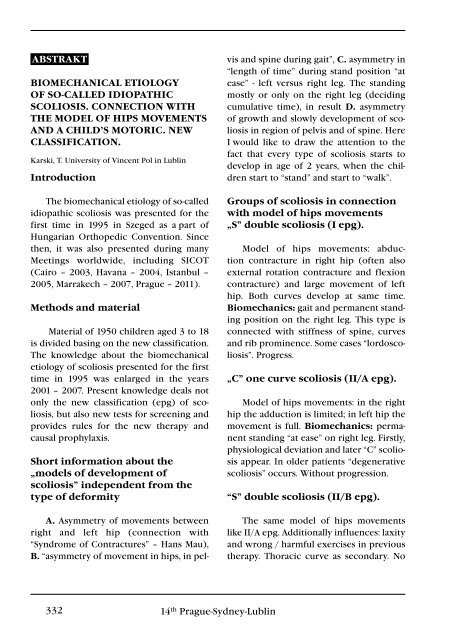3+4+Supplementum/2012 - Společnost pro pojivové tkáně
3+4+Supplementum/2012 - Společnost pro pojivové tkáně
3+4+Supplementum/2012 - Společnost pro pojivové tkáně
- TAGS
- www.pojivo.cz
You also want an ePaper? Increase the reach of your titles
YUMPU automatically turns print PDFs into web optimized ePapers that Google loves.
aBSTRakT<br />
BiOMeCHaniCal eTiOlOGY<br />
Of SO-Called idiOPaTHiC<br />
SCOliOSiS. COnneCTiOn wiTH<br />
THe MOdel Of HiPS MOVeMenTS<br />
and a CHild’S MOTORiC. new<br />
ClaSSifiCaTiOn.<br />
Karski, T. University of Vincent Pol in Lublin<br />
introduction<br />
The biomechanical etiology of so-called<br />
idiopathic scoliosis was presented for the<br />
first time in 1995 in Szeged as a part of<br />
Hungarian Orthopedic Convention. Since<br />
then, it was also presented during many<br />
Meetings worldwide, including SICOT<br />
(Cairo – 2003, Havana – 2004, Istanbul –<br />
2005, Marrakech – 2007, Prague – 2011).<br />
Methods and material<br />
Material of 1950 children aged 3 to 18<br />
is divided basing on the new classification.<br />
The knowledge about the biomechanical<br />
etiology of scoliosis presented for the first<br />
time in 1995 was enlarged in the years<br />
2001 – 2007. Present knowledge deals not<br />
only the new classification (epg) of scoliosis,<br />
but also new tests for screening and<br />
<strong>pro</strong>vides rules for the new therapy and<br />
causal <strong>pro</strong>phylaxis.<br />
Short information about the<br />
„models of development of<br />
scoliosis” independent from the<br />
type of deformity<br />
a. Asymmetry of movements between<br />
right and left hip (connection with<br />
“Syndrome of Contractures” – Hans Mau),<br />
B. “asymmetry of movement in hips, in pel-<br />
332 14 th Prague-Sydney-Lublin<br />
vis and spine during gait”, C. asymmetry in<br />
“length of time” during stand position “at<br />
ease” - left versus right leg. The standing<br />
mostly or only on the right leg (deciding<br />
cumulative time), in result d. asymmetry<br />
of growth and slowly development of scoliosis<br />
in region of pelvis and of spine. Here<br />
I would like to draw the attention to the<br />
fact that every type of scoliosis starts to<br />
develop in age of 2 years, when the children<br />
start to “stand” and start to “walk”.<br />
Groups of scoliosis in connection<br />
with model of hips movements<br />
„S” double scoliosis (i epg).<br />
Model of hips movements: abduction<br />
contracture in right hip (often also<br />
external rotation contracture and flexion<br />
contracture) and large movement of left<br />
hip. Both curves develop at same time.<br />
Biomechanics: gait and permanent standing<br />
position on the right leg. This type is<br />
connected with stiffness of spine, curves<br />
and rib <strong>pro</strong>minence. Some cases “lordoscoliosis”.<br />
Progress.<br />
„C” one curve scoliosis (ii/a epg).<br />
Model of hips movements: in the right<br />
hip the adduction is limited; in left hip the<br />
movement is full. Biomechanics: permanent<br />
standing “at ease” on right leg. Firstly,<br />
physiological deviation and later “C” scoliosis<br />
appear. In older patients “degenerative<br />
scoliosis” occurs. Without <strong>pro</strong>gression.<br />
“S” double scoliosis (ii/B epg).<br />
The same model of hips movements<br />
like II/A epg. Additionally influences: laxity<br />
and wrong / harmful exercises in previous<br />
therapy. Thoracic curve as secondary. No

















